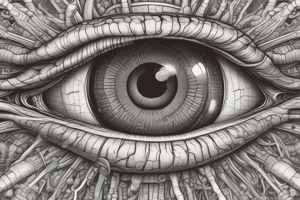Podcast
Questions and Answers
What organ serves as the information centre in the human body?
What organ serves as the information centre in the human body?
- Heart
- Liver
- Lungs
- Brain (correct)
Which component is NOT part of the nervous system?
Which component is NOT part of the nervous system?
- Nerves
- Spinal cord
- Brain
- Kidneys (correct)
What is the role of sensory neurons in the nervous system?
What is the role of sensory neurons in the nervous system?
- Connect the brain to other parts of the body
- Transmit signals to muscles
- Carry impulses from sense organs to the brain or spinal cord (correct)
- Interpret received information
What is the term for the effectors in a reflex arc?
What is the term for the effectors in a reflex arc?
How do relay neurons contribute to reflex actions?
How do relay neurons contribute to reflex actions?
What is the main function of the nervous system?
What is the main function of the nervous system?
Which of the following is primarily responsible for responding to a specific stimulus?
Which of the following is primarily responsible for responding to a specific stimulus?
In a reflex action, what do sensory receptors primarily do?
In a reflex action, what do sensory receptors primarily do?
What occurs to the pupil when light intensity increases?
What occurs to the pupil when light intensity increases?
Which of the following actions happens to the pupil in low light conditions?
Which of the following actions happens to the pupil in low light conditions?
What physiological process causes the pupil to change size?
What physiological process causes the pupil to change size?
What could cause the pupils to dilate apart from changes in light intensity?
What could cause the pupils to dilate apart from changes in light intensity?
During a fight-or-flight response, what happens to the pupils?
During a fight-or-flight response, what happens to the pupils?
What is the main role of pupil dilation in low light situations?
What is the main role of pupil dilation in low light situations?
Which of the following best describes the mechanism of pupil constriction when bright light is present?
Which of the following best describes the mechanism of pupil constriction when bright light is present?
Why would someone experience pupil dilation when in a state of danger?
Why would someone experience pupil dilation when in a state of danger?
Which of the following structures are part of the central nervous system?
Which of the following structures are part of the central nervous system?
What is the primary function of nerves in the nervous system?
What is the primary function of nerves in the nervous system?
How are neurons related to nerves?
How are neurons related to nerves?
What is a synapse in the context of the nervous system?
What is a synapse in the context of the nervous system?
What is presbyopia primarily characterized by?
What is presbyopia primarily characterized by?
Which factor is a possible cause of presbyopia?
Which factor is a possible cause of presbyopia?
What is the significance of reflex arcs in the nervous system?
What is the significance of reflex arcs in the nervous system?
In a scenario where multiple stimuli are received, what allows the nervous system to respond to different effectors simultaneously?
In a scenario where multiple stimuli are received, what allows the nervous system to respond to different effectors simultaneously?
How does decreased lens elasticity affect vision?
How does decreased lens elasticity affect vision?
What role does age play in presbyopia?
What role does age play in presbyopia?
What type of action is primarily mediated by nerve impulses traveling from the brain to effectors?
What type of action is primarily mediated by nerve impulses traveling from the brain to effectors?
Which process describes the pathway of nerve impulses that leads to the body’s response to stimuli?
Which process describes the pathway of nerve impulses that leads to the body’s response to stimuli?
Which is NOT a typical measure used to correct presbyopia?
Which is NOT a typical measure used to correct presbyopia?
What might a common symptom of presbyopia be?
What might a common symptom of presbyopia be?
What is a common misconception about presbyopia?
What is a common misconception about presbyopia?
How can presbyopia be effectively managed?
How can presbyopia be effectively managed?
What is the primary process of adjusting the lens of the eye to form clear images called?
What is the primary process of adjusting the lens of the eye to form clear images called?
What must occur for light rays to form a clear image on the retina?
What must occur for light rays to form a clear image on the retina?
How does the shape of the lens change when focusing on a distant object?
How does the shape of the lens change when focusing on a distant object?
What is indicated by the near point of the eye?
What is indicated by the near point of the eye?
What effect does moving an object closer to the eyes have on the lens?
What effect does moving an object closer to the eyes have on the lens?
What is the purpose of focusing in the human eye?
What is the purpose of focusing in the human eye?
Which of the following statements about the lens is accurate?
Which of the following statements about the lens is accurate?
What happens to the near point as a person ages?
What happens to the near point as a person ages?
Study Notes
Nervous System Overview
- Central nervous system consists of the brain, spinal cord, and nerves, regulating bodily functions and responses to stimuli.
- Communication pathways involve receptors, sensory neurones, relay neurones, motor neurones, and effectors to coordinate reflex actions.
Eye Structure and Function
- The human eye is structured to facilitate vision by focusing light onto the retina.
- Focusing, or accommodation, adjusts the lens shape for clear images of objects at varying distances.
Reflex Actions
- Reflex actions involve a quick response to specific stimuli through a pathway known as the reflex arc.
- Sensory information is transmitted to the brain to trigger a response, which is then sent to effectors (muscles or glands).
Presbyopia
- Presbyopia is a condition characterized by the loss of lens elasticity, impacting the ability to focus on nearby objects, leading to blurry vision.
- Commonly occurs with age as the lens becomes less flexible.
Pupil Response
- The pupil can constrict and dilate in response to changes in light intensity.
- Pupils also dilate due to emotional reactions, such as fear or excitement, driven by hormonal changes.
Measures for Vision Correction
- Various corrective measures exist for vision impairments, including glasses, contact lenses, and surgical options; each work by adjusting light entry for clearer images on the retina.
Near Point of Focus
- The near point is the closest distance at which an object can be seen clearly. This is important in assessing vision and determining necessary corrective measures.
Additional Concepts
- Synapses serve as junctions for nerve impulses, allowing simultaneous transmission to multiple effectors.
- Understanding the interaction between the central nervous system and sensory experiences is critical for grasping how organisms react to their environment.
Studying That Suits You
Use AI to generate personalized quizzes and flashcards to suit your learning preferences.
Description
Explore Chapter 10 of 'Biology Matters for GCE 'O' Level' focusing on the Nervous System and the Eye. This quiz will challenge your understanding of key concepts related to these essential topics in biology. Test your knowledge and deepen your appreciation for the human body's information processing systems.





